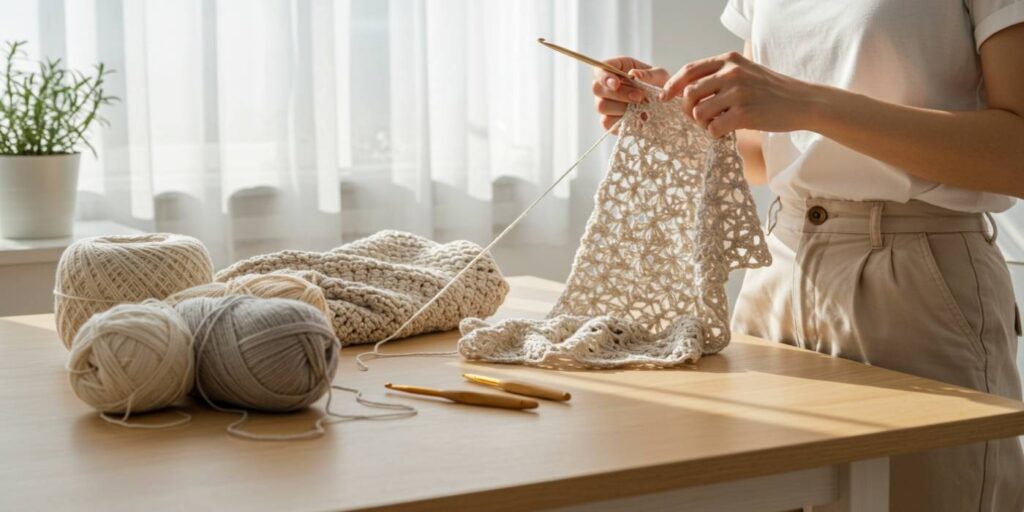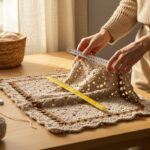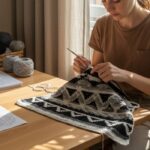Introduction: Less Really Is More — Especially in Crochet
Imagine wrapping yourself in something handmade — soft, warm, and quietly elegant — without the overwhelm of complex stitches, tangled yarn, or patterns that demand hours of decoding. That’s the magic of minimalist crochet.
In a world buzzing with noise, clutter, and constant stimulation, minimalist crochet offers a gentle rebellion. It’s not about doing less — it’s about choosing better. Clean lines. Thoughtful stitches. Projects that soothe your soul as much as they serve your space or style. Whether you’re new to crochet or a seasoned maker craving simplicity, this approach invites you to slow down, savor each loop, and create beauty that doesn’t shout… but whispers.
In this article, we’ll explore why minimalist crochet is more than just a trend — it’s a mindful practice. You’ll discover how to choose the right materials, master foundational stitches that do the heavy lifting, and design projects that look effortlessly chic (even if you’re still learning). We’ll also share real-life inspiration, practical tips for avoiding overwhelm, and how embracing simplicity can actually expand your creativity — not limit it.
Ready to strip away the excess and stitch with intention? Let’s begin.
1. Why Minimalist Crochet? The Quiet Power of Simplicity
Minimalist crochet isn’t about restriction — it’s about focus.
Think of it like decluttering your yarn stash: you’re not throwing everything away, you’re curating what truly matters. The result? Projects that feel intentional, calming, and deeply satisfying.
Why does this resonate so deeply right now?
We’re living in an age of “more.” More patterns. More colors. More stitches. More pressure to make it “Pinterest-perfect.” But many crafters — especially after years of intricate lace shawls or amigurumi marathons — are craving space to breathe. Minimalist crochet answers that call.
It’s therapeutic. Repetitive, rhythmic stitches become meditative. A simple rectangle scarf or a single-color blanket lets your hands move while your mind unwinds. No counting rows every five minutes. No color changes to track. Just you, your hook, and the quiet hum of creation.
Real-life example: Sarah, a graphic designer from Portland, started minimalist crochet during a burnout phase. “I was tired of complicated patterns that felt like work,” she says. “Now, I make chunky stitch blankets in neutral tones. It’s my therapy — and my living room looks like a Scandinavian dream.”
Minimalist crochet also scales beautifully. Got 15 minutes? Make a coaster. Got a weekend? Stitch a throw. It adapts to your rhythm — not the other way around.
And aesthetically? Clean lines and monochrome palettes never go out of style. Minimalist pieces blend seamlessly into modern, boho, rustic, or even industrial interiors. They’re the little black dress of the crochet world — versatile, timeless, and always appropriate.
2. The Minimalist Crochet Toolkit: Less Gear, More Joy
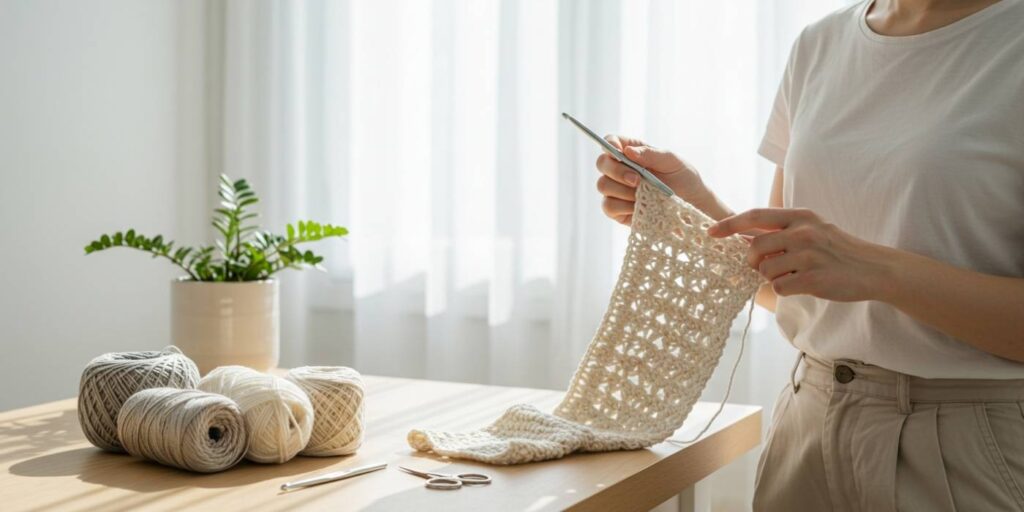
You don’t need a craft room bursting with supplies to make beautiful minimalist crochet. In fact, too many options can paralyze creativity. Let’s simplify your toolkit — without sacrificing quality or joy.
Start with the basics:
- One great hook. Seriously. Not ten. Not the whole set. Pick a size that feels good in your hand — maybe a 5mm or 6mm for medium-weight yarn — and master it. Wooden or ergonomic hooks reduce hand fatigue during long sessions.
- Yarn with character (but not chaos). Look for solid, tonal, or subtly variegated yarns in natural fibers like cotton, wool, or bamboo. Avoid busy prints or neon color shifts — they fight against the minimalist vibe. A creamy off-white, soft gray, or warm oatmeal? Perfect.
- Scissors, tapestry needle, stitch markers. That’s it. No fancy stitch counters or row keepers needed. Minimalist crochet thrives on intuition.
Pro tip: Build a “capsule yarn stash.” Choose 3–5 core colors that complement each other and your home decor. When inspiration strikes, you’re not digging through bins — you’re grabbing and going.
Why this matters:
Clutter = stress. Even creative clutter. By paring down your tools and materials, you remove decision fatigue. No more standing in the yarn aisle for 45 minutes wondering which variegated skein “speaks to you.” You already know your palette. Your hook is ready. Your mind is clear.
This simplicity also makes crochet more accessible. Traveling? Toss your capsule kit in a tote. Crocheting at a café? No bulky bags or 12 different hooks clinking around. Minimalist crochet fits into your life — not the other way around.
And financially? You save money. No impulse buys. No half-used skeins collecting dust. You invest in quality over quantity — and your projects reflect that.
3. Foundational Stitches That Do the Heavy Lifting
You don’t need to know 50 stitches to make stunning minimalist crochet. In fact, mastering just a handful can carry you through dozens of projects — all with that clean, modern aesthetic.
Here are the MVPs (Most Valuable Patterns) of minimalist crochet:
Single Crochet (sc)
The quiet achiever. Tight, dense, and perfect for structured pieces like coasters, placemats, or modern pouches. Worked in rows or spirals, it creates a smooth, almost woven look.
Half Double Crochet (hdc)
The Goldilocks stitch — not too loose, not too tight. Slightly taller than sc, it works up faster and has beautiful drape. Ideal for scarves, lightweight blankets, or market totes.
Double Crochet (dc)
The showstopper of simplicity. Tall, open, and airy — especially when worked with a larger hook. Creates beautiful texture with minimal effort. Use it for lacy shawls, breezy tops, or statement blankets.
Moss Stitch (aka Linen Stitch)
Alternating sc and chain stitches create a woven, textured fabric that looks far more complex than it is. Reversible and stunning in solids. Perfect for pillow covers or minimalist cardigans.
Granny Stripe (simplified)
Forget the rainbow granny square. Try a single-color granny stripe using only dc clusters. It’s rhythmic, fast, and creates bold horizontal lines — ideal for throws or wall hangings.
Why these stitches win:
- They’re easy to memorize.
- Mistakes are forgiving (or easily hidden).
- They scale beautifully — same stitch, different hook or yarn = totally new look.
- They photograph well (important if you share your makes online!).
Try this: Pick one stitch this week. Make a 6×6” swatch. Then make another in a different weight yarn. Notice how the same stitch transforms. That’s the secret of minimalist crochet — depth through repetition, not complexity.
4. Project Ideas: Minimalist Crochet That Makes a Statement
Minimalist doesn’t mean boring. It means intentional. Here are five projects that prove simplicity can be seriously stunning — and surprisingly quick to make.
1. The “One Skein Wonder” Scarf
Yarn: 1 skein bulky wool (approx. 100–120 yards)
Stitch: hdc or dc
Time: 2–3 hours
Why it works: Chunky, cozy, and requires zero pattern-reading. Start at one end, stitch until you run out of yarn. Fringe optional. Instant gratification + maximum style.
2. Modern Coaster Set
Yarn: Cotton in 2–3 coordinating neutrals
Stitch: sc or moss stitch
Time: 30 minutes per coaster
Why it works: Practical, giftable, and a great way to test color combos. Stack them on your coffee table for instant zen vibes.
3. Oversized Throw Blanket
Yarn: 6–8 skeins super bulky (or hold 2 strands of worsted together)
Stitch: dc or granny stripe
Time: Weekend project
Why it works: Minimalist crochet shines in large-scale pieces. The repetition is meditative, and the result? A cloud-like blanket that anchors your entire living room.
4. Structured Market Tote
Yarn: Cotton or jute blend
Stitch: sc for body, dc for handles
Time: 1–2 evenings
Why it works: Ditch the plastic bags. This sturdy, no-frills tote gets better with use. Bonus: stitch your initials in a corner for subtle personalization.
5. Wall Hanging / Textile Art
Yarn: Leftover scraps or ombre set in one color family
Stitch: Freeform clusters, fringe, macramé-inspired knots
Time: As long (or short) as you like
Why it works: Minimalist crochet meets interior design. Hang it above your bed, desk, or entryway. No frame needed — the texture is the art.
Pro tip: Keep a “minimalist project journal.” Sketch quick ideas, note yarn combos you love, or paste in photos of inspiring interiors. It becomes your personal style guide — no Pinterest required.
5. Designing Your Own Minimalist Patterns (Yes, You Can!)

You don’t need to be a crochet designer to create your own minimalist patterns. In fact, the beauty of this style is how adaptable it is. Here’s how to start designing with confidence — even if you’ve never written a pattern before.
Step 1: Start with a shape. Minimalist crochet loves geometry. Think rectangles, squares, circles, or half-circles. Scarf? Rectangle. Placemat? Square. Shawl? Triangle or crescent. Define your shape first — the stitches will follow.
Step 2: Choose your stitch + yarn combo. Refer back to your MVP stitches. Pick one. Then pick a yarn weight. Swatch it. Does it drape how you want? Is the texture pleasing? Adjust hook size if needed.
Step 3: Set your dimensions. Measure what you’re making. Scarf: 8” wide x 60” long. Blanket: 40” x 50”. Write it down. Now calculate your starting chain (based on your swatch gauge). No need to be exact — minimalist crochet forgives slight variations.
Step 4: Add one intentional detail. Minimalism isn’t empty — it’s curated. Add one thoughtful element:
- A single row of contrasting edging
- One oversized tassel
- A hidden pocket
- A subtle texture shift (e.g., switch from dc to sc for the last 5 rows)
Step 5: Document as you go. Jot down what you did. “Ch 40. Hdc in 2nd ch from hook, hdc to end. 39 sts. Row 2: Ch 2 (counts as hdc), turn, hdc in each st across.” That’s your pattern. Save it. Reuse it. Gift it.
Real talk: Your first self-designed project won’t be perfect. And that’s okay. Minimalist crochet celebrates the handmade — slight imperfections add character. You’re not mass-producing. You’re creating something only you could make.
6. Mindset Shift: How Minimalist Crochet Changes Your Relationship with Making
This isn’t just about yarn and hooks — it’s about how you approach creativity.
Minimalist crochet invites you to:
- Release perfectionism. That slightly uneven edge? It’s proof of your humanity. Minimalist pieces often look better with a little organic irregularity.
- Embrace “slow making.” There’s no rush. Let a project sit for a week. Come back when you feel called. Crochet shouldn’t be another item on your to-do list.
- Celebrate function. A coaster that protects your table. A scarf that warms your neck. A blanket that invites cuddles. These aren’t “just crafts” — they’re daily acts of care.
- Let go of comparison. Your minimalist scarf doesn’t need 10K Instagram likes. It needs to feel good around your shoulders. That’s the metric that matters.
Story time: Maria, a retired teacher in Florida, used to crochet elaborate baby blankets for every new mom in her family. “I loved it, but I was exhausted,” she admits. Now? She makes one minimalist blanket a year — in a gender-neutral oatmeal wool. “I stitch it slowly. I gift it with love. And I actually enjoy the process again.”
That’s the heart of it. Minimalist crochet isn’t about making less — it’s about making meaningfully.
7. Troubleshooting & Tips: Keeping It Simple (When Life Isn’t)
Even minimalist crochet can feel overwhelming sometimes. Here’s how to stay on track — without guilt.
Problem: “I keep starting projects and abandoning them.”
Solution: Commit to “one WIP (work in progress) only.” No new project until the current one is done — or consciously frogged (ripped out). Minimalism includes your project queue.
Problem: “I don’t know what to make next.”
Solution: Ask: What do I need? Not want. Need. A new phone cozy? A plant hanger? A bookmark? Let function lead.
Problem: “My tension is uneven.”
Solution: Don’t fixate. Embrace it. Or — switch to a bulkier yarn and larger hook. Imperfections disappear in chunky textures.
Problem: “I’m bored with solids.”
Solution: Try tonal yarns (same color, subtle shade shifts) or add one accent row in a complementary hue. Minimalism allows for whispers of contrast.
Bonus Tip: Create a “crochet ritual.”
Light a candle. Put on a lo-fi playlist. Pour tea. Make the act of crocheting as intentional as the project. This isn’t multitasking — it’s mindfulness.
Conclusion: Stitch by Stitch, Create Space for What Matters
Minimalist crochet isn’t a style. It’s a sanctuary.
In a world that shouts, it whispers. In a culture of excess, it chooses enough. In a craft often tangled in complexity, it finds peace in repetition.
We’ve explored how to pare down your tools, master foundational stitches, design your own patterns, and shift your mindset from “more” to “meaningful.” You’ve seen how a simple rectangle can become a treasured heirloom — not because it’s intricate, but because it’s infused with presence.
So pick up your hook. Choose one skein. Cast on without overthinking. Let your hands move. Let your mind rest. Create not to impress — but to express. To comfort. To connect.
Your next minimalist project won’t just be something you make. It’ll be something you experience — stitch by quiet stitch.
Now it’s your turn.
What’s the first minimalist crochet project you’ll try? A scarf? A coaster? A blanket to wrap yourself in while reading? Share in the comments — I’d love to hear what calls to you. And if this resonated, pass it on to a fellow maker who needs permission to simplify.
Because sometimes, the most beautiful things are born not from complexity… but from calm.
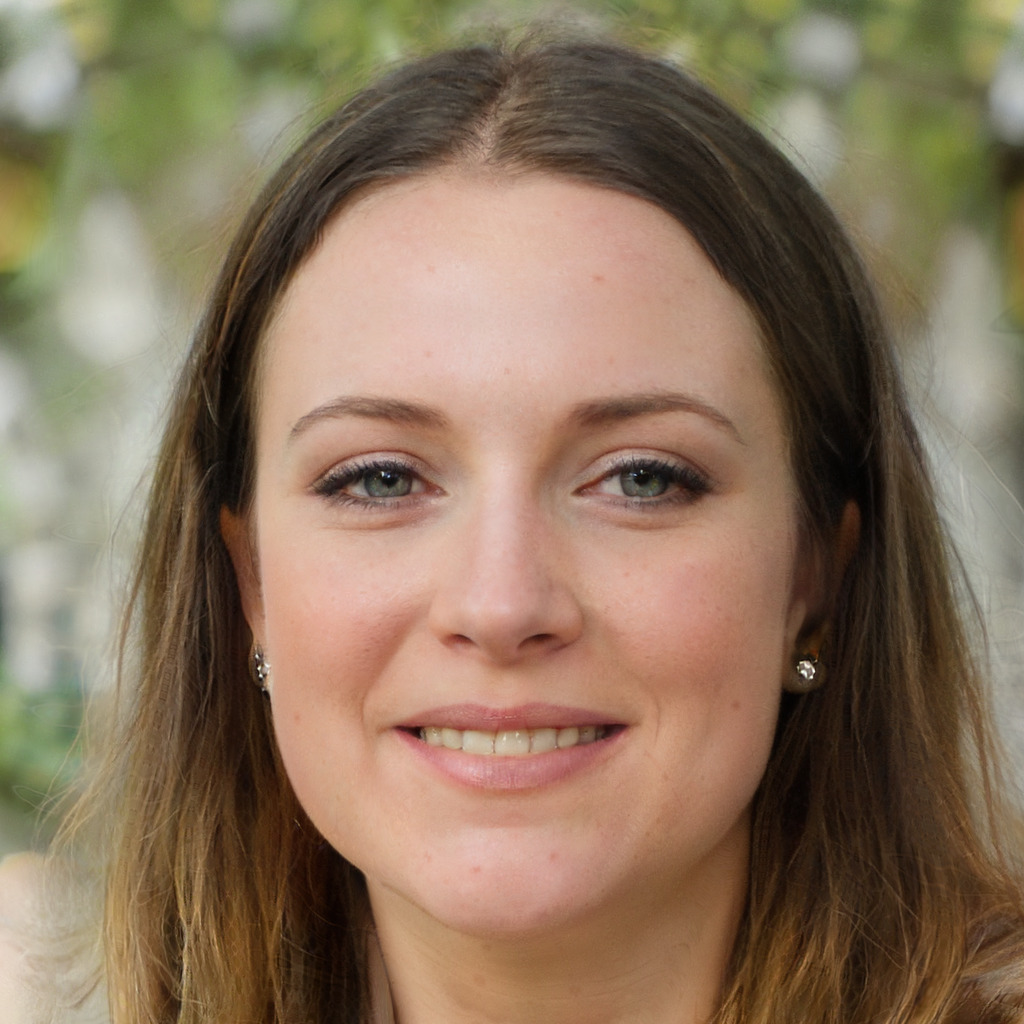
Daniele Ferreira is passionate about the world of crochet, dedicating her time to exploring techniques, creating unique pieces, and sharing her knowledge with beginners and aficionados alike. With attention to detail and creativity, she transforms yarn into true works of art, inspiring others to discover the beauty and joy of this manual art.

